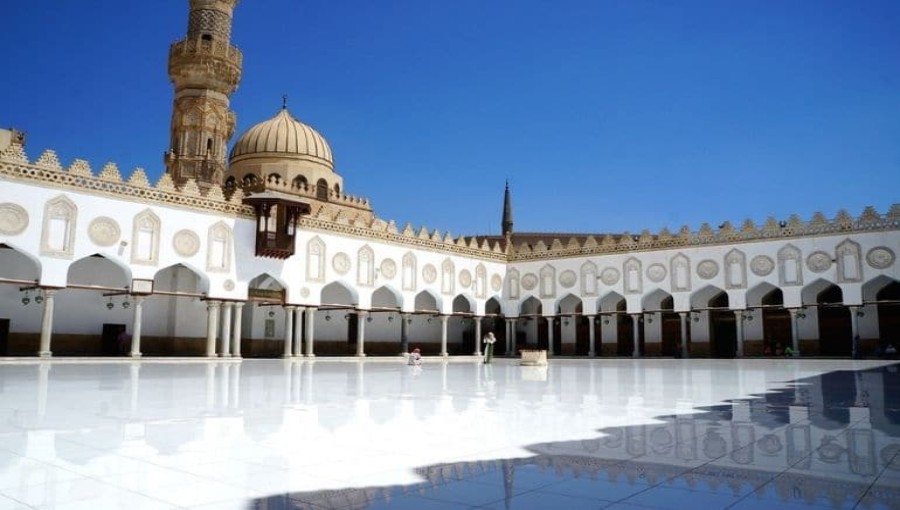Al-Azhar Mosque, located in the heart of Islamic Cairo, is one of the oldest and most influential mosques in Egypt and the Muslim world. It is not only a place of worship, but also a prestigious institution of Islamic learning that has shaped the religious and intellectual history of Sunni Islam for over a millennium. In this article, we will explore the origins, architecture, significance, and controversies of this remarkable mosque and its affiliated university.
Origins and History
Step into the vibrant tapestry of history woven within the walls of Al-Azhar Mosque, an enduring symbol of scholarship and faith. Founded in 970 CE by the illustrious Fatimid general Jawhar al-Siqilli, this magnificent edifice was a testament to the rich heritage of Islam. Named after Fatimah al-Zahra, the beloved daughter of Prophet Muhammad, it radiated with the luminosity of her legacy.

In 988 CE, under the enlightened rule of Caliph al-Aziz Billah, Al-Azhar transformed into a beacon of knowledge, birthing what would become the second oldest continuously running university in the world. Here, the esoteric mysteries of Ismailism intertwined seamlessly with the exoteric sciences of the Quran, igniting the minds of scholars and students alike.
Video: Al-Azhar Mosque: A Historical Gem of Islamic Architecture and Education
Yet, as the sands of time-shifted, so did the fortunes of Al-Azhar. The Ayyubids, with their Sunni fervour, cast a shadow over its Shia origins, relegating it to the fringes of society. But like a phoenix rising from the ashes, the Mamluks breathed new life into its hallowed halls, adorning it with splendour and wisdom.
Under Ottoman rule, Al-Azhar flourished as a bastion of Sunni learning, embracing modernity with the introduction of the printing press and innovative curricula. The winds of change blew once more with the Muhammad Ali Dynasty, ushering in an era of reform and rivalry as secular institutions vied for prominence.

Yet, through tumult and transformation, Al-Azhar endured, standing as a resilient monument to faith and enlightenment. In the embrace of the Egyptian Republic, it found a new purpose and independence, spreading its influence far and wide.
Today, as echoes of the past resonate within its sacred walls, Al-Azhar Mosque remains not just a testament to history, but a living testament to the enduring pursuit of knowledge and spiritual enlightenment.
Architecture and Design
Al-Azhar Mosque transcends its role as a place of worship. It's a magnificent architectural tapestry, a testament to the artistic legacy of various Islamic dynasties. Spanning over 15,600 square meters, it boasts five entrances, each inviting you into a different era.

Step inside the prayer hall, the heart of the mosque. Here, over 380 marble columns stand sentinel, some whispering tales of the Fatimid era, while others were added by later rulers. Look up and admire the symphony of domes - the Fatimid dome gracing the main mihrab, a stark contrast to the Mamluk dome adorning the entrance and the Ottoman dome bathing the central nave in its soft light.

The serene courtyard beckons next. Imagine the murmur of prayers echoing through the porticoes that surround this tranquil space. A central fountain stands ready for ablutions, while a hidden gem, the 14th-century library, promises forgotten knowledge.


Finally, explore the mausoleum, a treasure trove built by the Ottomans, housing the tomb of the mosque's founder. Each architectural detail, from the minarets reflecting the styles of different dynasties to the exquisite domes and the serene courtyard, narrates a chapter in Al-Azhar's rich history.
Significance and Influence
Al-Azhar Mosque's significance extends far beyond its architectural beauty. It has served as a cultural and intellectual powerhouse for centuries, shaping the course of Islamic knowledge and civilization. Renowned scholars have walked its halls, leaving behind an invaluable legacy.
Imagine luminaries like Imam al-Dhahabi, the meticulous historian who documented the lives of prominent figures. Or think of Imam Ibn Hajar al-Asqalani, whose insightful commentary on Islamic scripture remains a cornerstone of Islamic scholarship.
Al-Azhar has also been a breeding ground for prolific minds like Imam al-Suyuti, who authored over 700 works on various Islamic disciplines. Reformers like Imam al-Shawkani championed independent reasoning within Islamic law, challenging blind adherence to tradition.

In the 20th century, figures like Imam Muhammad Abduh emerged, advocating for the modernization of Islamic thought and education. These are just a few examples of the countless scholars who have been shaped by or contributed to Al-Azhar's intellectual legacy.
The influence of Al-Azhar transcends geographical boundaries. It has served as a beacon of knowledge for students worldwide, fostering a vibrant intellectual exchange and shaping Islamic thought across the globe.































Comment: